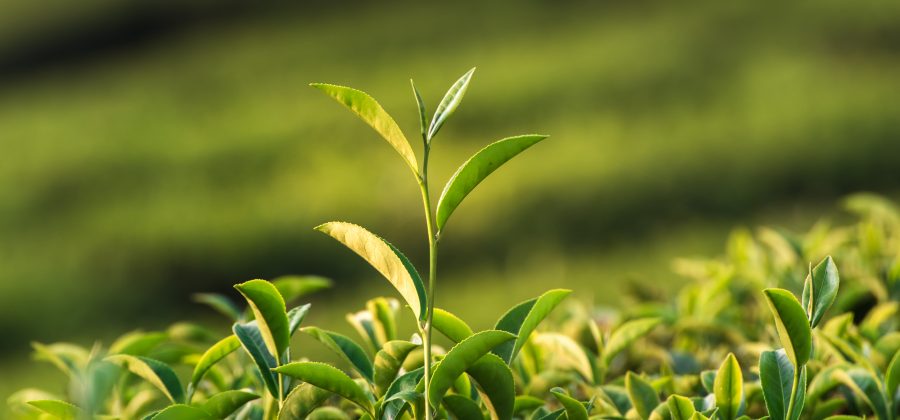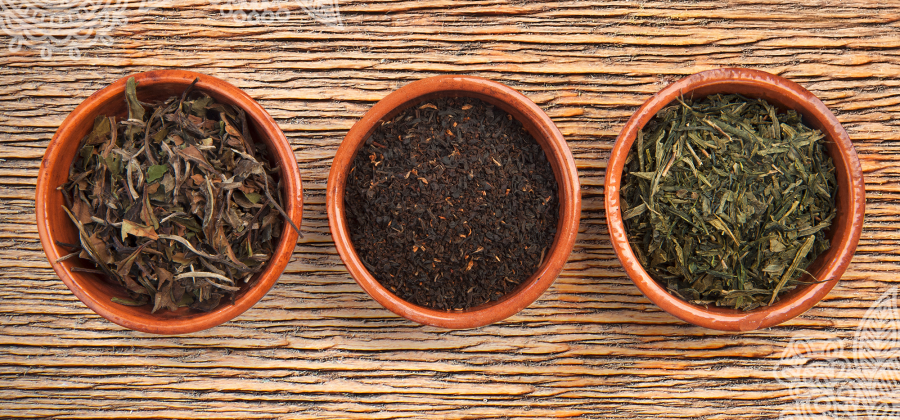One plant, three tea varieties: all about white, green and black tea
White, green or black? What is the difference?
We often receive this question and we are pleased to explain the difference between the various types of tea.
A question of processing.
Did you know that the three types of white, green and black tea actually come from the same plant? This plant is the Camellia Sinensis, which is native to an area covering southern Japan, Korea and the southern half of China, all the way to North-Eastern India.

The method of processing decides which tea becomes a black, green or white tea.
The deciding factor here is the so-called fermentation. This is not fermentation in the normal definition, but an oxidisation process. Cellular enzymes and other ingredients of the tea leaf are activated by oxygen. This leads to a discolouration of the tea, and the aroma unfolds. Black tea for example obtains its typical brown-black colour in this process.
In contrast to black tea, green tea is treated with steam after being harvested. This deactivates the oxidisation. The leaves remain olive green and the tea obtains its typical slightly green colour.
Similarly to the green tea, fermentation is also interrupted for white tea. The leaves only oxidise briefly and are then dried. This gives the tea its very distinctive character. White tea gets its name from a fine white “fuzz”, which envelopes the tea leaves and gives them an almost silvery appearance. The tea is also unusual as only the upper leaves of the blossom bud of the tea plant are used, which are dried carefully in special light and atmospheric conditions.
The little YOGI TEA® tea primer
Would you like to find out even more about the difference between the tea varieties? No problem.
Black tea was an established part of Asian tea culture centuries ago. Today, it is amongst the most popular of all types of tea throughout the world. Due to its high caffeine content, it i soften seen as an alternative to coffee. Black tea tastes pleasantly bitter and aromatic.
- We use black tea in the YOGI TEA® Black Chai
Black tea (Assam) grows in the region of the same name in the north of India. It is picked solely by hand and had a soft, malty and sweet character. Its robust and spicy taste makes it one of the most frequently consumed tea varieties worldwide.
- We use Assam tea in the YOGI TEA® Positive Energy Cranberry Hibiscus
White tea was previously reserved for the use of the Chinese Imperial court – today, due to its fine aroma, the mild and soft taste and its complicated processing, it is still seen as one of the most valuable types of tea in the world.
- We use white tea in YOGI TEA® White Tea with Aloe Vera
Green tea Tencha is one of the premium tea varieties in Japan. The bright green Tencha leaves make up only 1% of the tea harvest there and are used as a basis for the special Matcha tea. Tencha obtains its extraordinary quality from an elaborate processing method. The Tencha is shaded in the last weeks before being harvested, as well as during drying in special drying ovens, allowing it to develop particularly valuable ingredients.
- We use Tencha green tea in our YOGI TEA® Green Tea Matcha Lemon
Green Tea Sencha is also described as the “Royal Variety of Green Tea”. It combines the best qualities of the tea plant and has a fresh, distinctive taste.
- We use Green Tea Sencha in the varieties Green Chai, Green Tea Ginger Lemon, Green Energy, Green Balance, Green Tea Matcha Lemon.

Tip!
Green Tea is also an excellent choice for cold drinks. Discover our ice tea with YOGI TEA® Green Chai or one of the other delicious YOGI TEA® on the rocks! → YOGI TEA® On Ice



